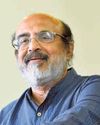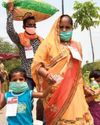يحاول ذهب - حر
Punjab: Behind The Decline
October 2, 2015
|FRONTLINE
Census figures show a negative growth rate for the Sikh population in Punjab, but it is the Sangh Parivar, not Sikhs, that uses this to stoke up communal tensions.

Why is there absolutely no rage among Sikhs over a constantly declining Sikh population in Punjab, as is evident in the latest Census figures? The State, which was carved out in 1966 as a Sikh-majority one after militant demands by the unified Akali Dal and other Sikh identity groups, should have been bursting out in anger. Not only is Punjab a Sikh-majority State, it has also been witness to one of the most violent wars of secession on religious lines for more than two decades.
After all, in the narrative of the Sangh Parivar—the proponent of “Akhand Hindu Rashtra”—Hindus may turn into a victimised minority in the future if the latest Census data on religious composition of the Indian population is something to go by. Various mouthpieces of the Sangh Parivar interpreted the decline of the Hindu population to a little less than 80 per cent as the most significant marker to justify its vitriolic propaganda that Muslims are deliberately reproducing more to counter the might of the Hindus in India.
Yet, the Census data created hardly a flutter among the Sikhs in Punjab. Barring a few insignificant extremist groups, none of the Sikh political parties, including various factions of the Akali Dal, has taken up the issue of declining Sikh population.
The 2011 Census shows that out of approximately 2.75 crore people in Punjab, 1.07 crore are Hindus, while 1.60 crores are Sikhs. Sikhs constitute 57.69 per cent of the population and Hindus, 38.49 per cent. The 1991 Census had shown Sikhs as constituting 62.95 per cent of the population of Punjab. The percentage has been coming down ever since. In the 2001 Census, Sikhs constituted 59.91 per cent of the population.
In contrast, the percentage of the Hindus in the population is growing; 34.46 per cent in the 1991 Census and 36.94 per cent in 2001. In terms of population growth rate, Hindus are growing much faster than Sikhs.
هذه القصة من طبعة October 2, 2015 من FRONTLINE.
اشترك في Magzter GOLD للوصول إلى آلاف القصص المتميزة المنسقة، وأكثر من 9000 مجلة وصحيفة.
هل أنت مشترك بالفعل؟ تسجيل الدخول
المزيد من القصص من FRONTLINE

FRONTLINE
How Not To Handle An Epidemic
The lockdowns were meant to buy time to put in place appropriate health measures and contain the coronavirus’ spread, but they have failed to achieve the objective and heaped immense misery on the marginalised sections of society. India is still in the exponential phase of the COVID-19 infection and community transmission is a reality that the government refuses to accept.
9 mins
June 5, 2020

FRONTLINE
Tragedy on foot
As the COVID-19-induced lockdown cuts the ground beneath their feet in Tamil Nadu, thousands of migrant workers are trudging along the highway to the relative safety of their upcountry homes.
11 mins
June 5, 2020

FRONTLINE
Sarpanchs as game changers
Odisha manages to keep COVID-19 well under control because of the strong participation of panchayati raj institutions and the community at the grass-roots level under the leadership of Chief Minister Naveen Patnaik.
7 mins
June 5, 2020

FRONTLINE
Scapegoating China
As the COVID-19 death rate spikes and the economy tanks in the United States, Donald Trump and his advisers target China and the World Health Organisation with an eye to winning the forthcoming presidential election.
10 mins
June 5, 2020

FRONTLINE
New worries
Kerala’s measured approach to the pandemic and lockdown has yielded results. But it still has to grapple with their huge economic impact on its economy, which it feels the Centre’s special financial relief package does little to alleviate.
9 mins
June 5, 2020
FRONTLINE
No love lost for labour
Taking advantage of the lockdown and the inability of workers to organise protests, many State governments introduce sweeping changes to labour laws to the detriment of workers on the pretext of reviving production and boosting the economy.
8 mins
June 5, 2020

FRONTLINE
Capital's Malthusian moment
In a world that needs substantial reorienting of production and distribution, Indian capital is resorting to a militant form of moribund neoliberalism to overcome its current crisis. In this pursuit of profit, it is ready and willing to throw into mortal peril millions whom it adjudicates as not worth their means—an admixture of social Darwinism born of capital’s avarice and brutalism spawned by Hindutva. .
14 mins
June 5, 2020

FRONTLINE
Understanding migration
When governments and their plans are found to be blatantly wanting in addressing reverse migration, exercises such as the Ekta Parishad’s survey of migrant workers throughout India can be useful to work out creative long-lasting solutions.
10 mins
June 5, 2020

FRONTLINE
Waiting for Jabalpur moment
The Supreme Court’s role in ensuring executive accountability during the ongoing lockdown leaves much to be desired. Standing in shining contrast is the record of some High Courts.
15 mins
June 5, 2020

FRONTLINE
An empty package
The Modi regime, which has been unable to control the COVID-19 infection, restore economic activity and provide relief to millions exposed to starvation, trains its sights on Indian democracy, making use of the panic generated by fear and a lockdown that forecloses paths of resistance.
17 mins
June 5, 2020
Translate
Change font size
